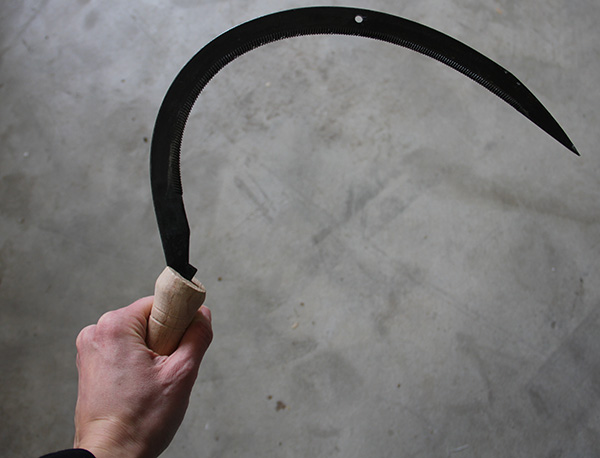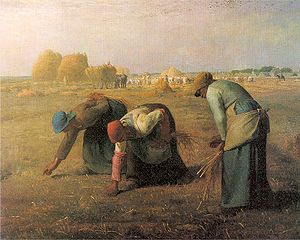Sickle
January 22nd, 2013
Last spring, the dearest wish of my heart was to own a scythe. You know, one of those old agricultural tools with a long curved handle, and metal blade. They were used to harvest grain before modern farm machinery took over.

Man with a Scythe, Eastman Johnson, 1868
Turns out though, scythes were primarily the domain of men. Something about upper body strength and reach, not to mention the possibility of cutting off a leg. Women stuck to the smaller, crescent-shaped sickle. At least in genre paintings (reference my ongoing obsession with Gleaner subjects).
So today, I finally purchased my first sickle. It’s got a wooden handle and a curved metal blade, lined with little teeth on the inside of the crescent.

Coincidentally, our yard is badly in need of a mow. So I had to go outside and give it a try. It’s surprisingly efficient. Especially with long grasses. You have to hold onto a clump with one hand, while you hack and saw at it simultaneously with the sickle, so lots of crouching is involved. But it gets the job done. I estimate it will take the better part of a day to mow our yard using the sickle. By then, I should be an expert.
Oh, and I’m already learning. It’s a good idea to wear heavy gloves while wielding something this sharp, that close to your knuckles…
Better than a Bouquet
October 1st, 2011
Every so often, someone gives me flowers — roses, orchids, freesias. But I’ve never been quite so tickled as I was today when my friend Rachel brought me a little sheaf of wheat.

Now I can really be a gleaner! And I’ve been introduced to the panoply of mid-19th century paintings depicting gleaners, including this iconic 1857 work by Jean-François Millet.

Now that I’ve got some wheat, I just need to compile a costume, build a studio background, and set up my tripod…
Gleaning
September 28th, 2011
I could have sworn I already posted this illustration and poem, but it doesn’t seem to turn up in any of my site searches. Perhaps it was in the previous version of Circa 1850…before that unfortunate database crash in November 2010? Regardless, here it is again, from The Brilliant, a gift book for 1850, published by T(imothy) S(hay) Arthur, of Arthur’s Lady’s Magazine fame.

THE GLEANER.
Soft, and calm, and very still,
Fell the sunlight on the hill;
When the sultry noontide hour
Gave it most its strengh and power,
Like a glow of soft delight,
On a face with gladness bright;
Telling both of joy and rest,
Gentlest when the happiest.Even thus—as calm as fair,
Resting from the morning’s care,
Leaned, at noon, the dreaming maid,
Where the wood made deepest shade;
Calling back a dear delight,
Whispered to her over night,
‘Neath the boughs whose rustlings seem,
Mingled with her music-dream.May thy dreamings, maiden fair!
Ever such a glory wear—
Ever dwell a smile as meek
On thy yet unshadowed cheek.
Now thy life, like sunshine on,
Even when the dreams are gone;
And when golden youth is past,
Prove the loveliest at the last.
Gleaners were certainly romanticized in the 19th century. Take Tess Durbeyfield for example, who’s apparent innocence is highlighted by her work in the fields even as the presence of her doomed infant belies it. Or Philip Carey who finally takes Sally to his breast after watching her work at harvesting all day. And of course, there is Ruth, the biblical wife par excellence, who remains faithful to her mother-in-law even after she is widowed!
I have a plan to photography myself as a gleaner. Just as soon as I have time to make the costume, probably based on this illustration. I would also love to glean some day. But I have yet to meet anyone with a field of wheat, let alone one in which they would be willing to release me and my scythe.
